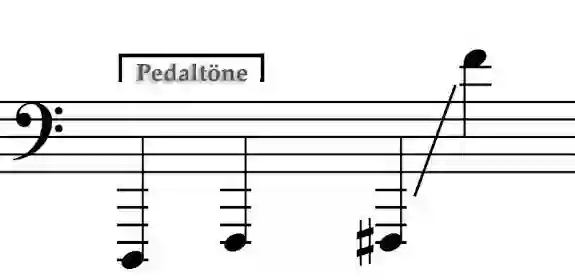Notation and sound generation » Bass tuba » Philipp Dangas
Notation and sound generation of the Bass tuba
The tone generation of the tubas is based on the same acoustic and technical rules that apply to the other cup mouthpiece instruments (overblowing, valve technology, etc.). However, the tubas have a special position compared to the other valve instruments used in the symphonic orchestra, i.e. compared to the trumpet and the horns, insofar as the strongly conical scale of their tube does not allow the natural scale to develop higher than about the natural tone No. 8. This is of crucial importance for both the overblowing technique and the tonal character of the instrument.
The bass tuba is built in 2 basic tunings, namely F and Eb. For our music, the bass tuba is relevant in (F) and its basic scale, which is the natural scale built on the F1, is the following: F1—a1 This basic scale with the help of the 4 valves can be lowered to G flat2. To generate the tones of the Ges2 scale, a compensation valve (the so-called F# valve) is usually also opened. The use of high tones (g' and a') is generally out of the question, since the best sound range of the low tubas is the middle register and the great depth. The high notes are better left to the horns.
It is generally up to the player which tuba he chooses to play a particular piece of music: if there are many very low passages for the tuba, he chooses a contrabass tuba or a particularly wide-bored bass tuba; if he has to play a lot of high notes, he chooses a normal one Bass tuba in F. An F/C double tuba is often used to play voices that lead both into the high range of the bass tuba and into the low range of the contrabass tuba.
[Composition by Shostakovich]
Download size: 173 kilobytes
Table summary of the playing techniques on the bass tuba
The following table lists the playing techniques and playing effects on the bass tuba shown. The playing techniques that are not suitable are also briefly mentioned.

The tonal range of a bass tuba in large scale
Internal search function
| Name | Value | Delete |
|---|